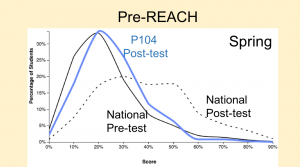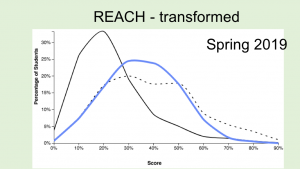Overview
- Educational research suggests that the more times one works with material, the better one understands it—this is one of the core principles of REACH.
- Physics 103 and 104 have been designed to give students as many chances as possible to engage with the physics principles and ideas they’ll be learning.
- Research also suggests that most students gain more out of STEM classes when they collaborate with peers, and so most parts of the course are designed to be done in groups. As such, students are expected to take part and fully participate in the parts of the course identified below.
“We are building a course that students will want to take
and instructors will want to teach”
Results
Since 2006 students in all of our introductory courses have taken standardized assessments of their understanding of physics concepts. Below are histograms of student scores for a survey of electricity and magnetism taken by Physics 104 students for a semester before the REACH transformation (left) and a semester afterwards (right). For comparison, shown in black are national averages for the test given to students before taking a particular course (pre-test: we do not have time to do this) and after (post-test).

